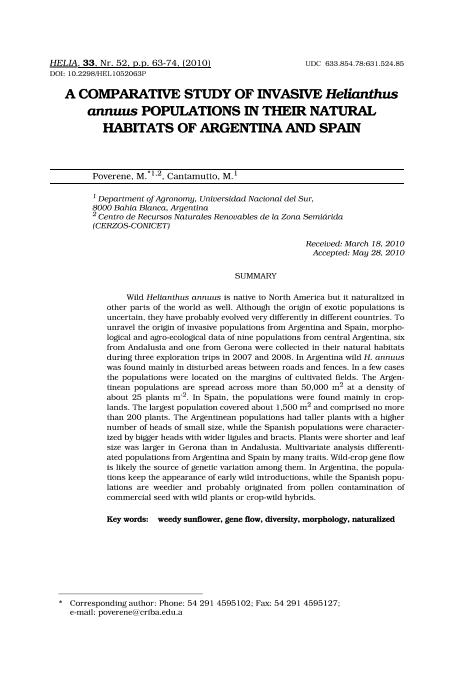Mostrar el registro sencillo del ítem
dc.contributor.author
Poverene, Maria Monica

dc.contributor.author
Cantamutto, M.

dc.date.available
2017-05-15T15:07:02Z
dc.date.issued
2010-05-28
dc.identifier.citation
Poverene, Maria Monica; Cantamutto, M.; A comparative study of invasive Helianthus annuus populations in their natural habitats of Argentina and Spain; Institute of Field and Vegetable Crops; Helia; 33; 52; 28-5-2010; 63-74
dc.identifier.issn
1018-1806
dc.identifier.uri
http://hdl.handle.net/11336/16468
dc.description.abstract
Wild Helianthus annuus is native to North America but it naturalized in other parts of the world as well. Although the origin of exotic populations is uncertain, they have probably evolved very differently in different countries. To unravel the origin of invasive populations from Argentina and Spain, morphological and agro-ecological data of nine populations from central Argentina, six from Andalusia and one from Gerona were collected in their natural habitats during three exploration trips in 2007 and 2008. In Argentina wild H. annuus was found mainly in disturbed areas between roads and fences. In a few cases the populations were located on the margins of cultivated fields. The Argentinean populations are spread across more than 50,000 m2 at a density of about 25 plants m-2. In Spain, the populations were found mainly in croplands. The largest population covered about 1,500 m2 and comprised no more than 200 plants. The Argentinean populations had taller plants with a higher number of heads of small size, while the Spanish populations were characterized by bigger heads with wider ligules and bracts. Plants were shorter and leaf size was larger in Gerona than in Andalusia. Multivariate analysis differentiated populations from Argentina and Spain by many traits. Wild-crop gene flow is likely the source of genetic variation among them. In Argentina, the populations keep the appearance of early wild introductions, while the Spanish populations are weedier and probably originated from pollen contamination of commercial seed with wild plants or crop-wild hybrids.
dc.format
application/pdf
dc.language.iso
eng
dc.publisher
Institute of Field and Vegetable Crops
dc.rights
info:eu-repo/semantics/openAccess
dc.rights.uri
https://creativecommons.org/licenses/by-nc-sa/2.5/ar/
dc.subject
Weedy Sunflower
dc.subject
Gene Flow
dc.subject
Diversity
dc.subject
Morphology
dc.subject
Naturalized
dc.subject.classification
Ecología

dc.subject.classification
Ciencias Biológicas

dc.subject.classification
CIENCIAS NATURALES Y EXACTAS

dc.title
A comparative study of invasive Helianthus annuus populations in their natural habitats of Argentina and Spain
dc.type
info:eu-repo/semantics/article
dc.type
info:ar-repo/semantics/artículo
dc.type
info:eu-repo/semantics/publishedVersion
dc.date.updated
2017-05-10T14:20:44Z
dc.journal.volume
33
dc.journal.number
52
dc.journal.pagination
63-74
dc.journal.pais
Serbia

dc.journal.ciudad
Novi Sad
dc.description.fil
Fil: Poverene, Maria Monica. Consejo Nacional de Investigaciones Científicas y Técnicas. Centro Científico Tecnológico Conicet - Bahía Blanca. Centro de Recursos Naturales Renovables de la Zona Semiarida. Universidad Nacional del Sur. Centro de Recursos Naturales Renovables de la Zona Semiarida; Argentina
dc.description.fil
Fil: Cantamutto, M.. Universidad Nacional del Sur; Argentina
dc.journal.title
Helia
dc.relation.alternativeid
info:eu-repo/semantics/altIdentifier/url/http://www.doiserbia.nb.rs/Article.aspx?id=1018-18061052063P&AspxAutoDetectCookieSupport=1
dc.relation.alternativeid
info:eu-repo/semantics/altIdentifier/doi/http://dx.doi.org/10.2298/HEL1052063P
Archivos asociados
